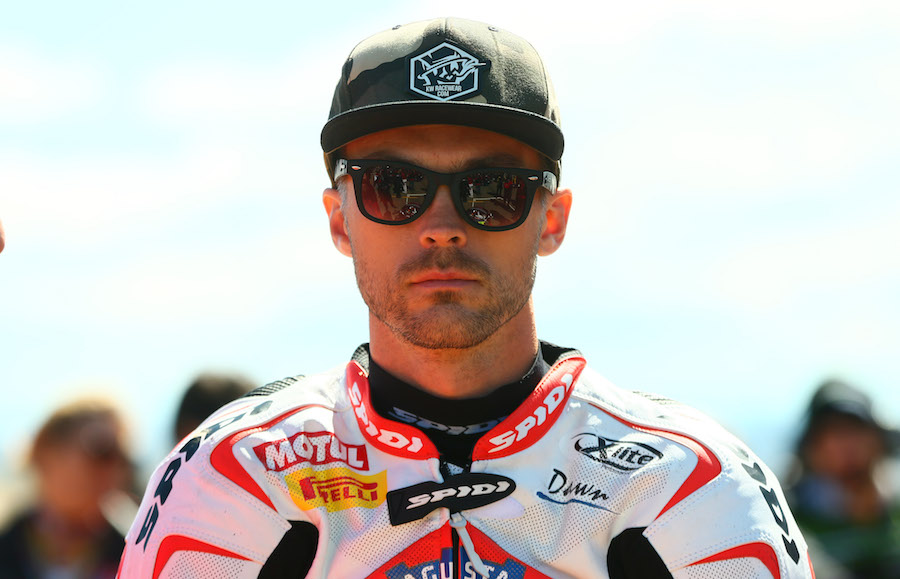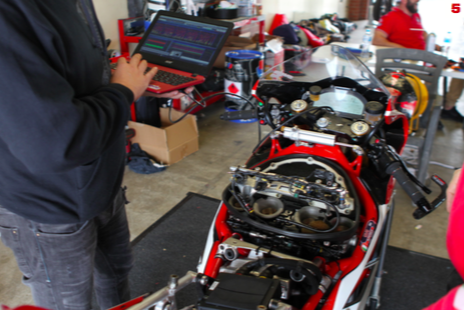When Leon Camier was done with his MV Agusta F4 RC, Aussie Sam Nehme bought it for his own enjoyment – and invited us to fang it round the track
Imagine the bike ad: 2016 MV F4 RC, one previous owner, low mileage, used only on the weekends, serviced every 100km, comes with plenty of spares … oh, and a bunch of factory mechanics.
When businessman Sam Nehme visited the Phillip Island round of the Superbike World Championship in February 2016, little did he know what it would end up costing him. Sam has always worked hard and been a passionate motorcyclist, especially when it comes to the iconic MV brand. He has collected some of the world’s most desirable models over the past 10 years, and this F4 RC could be the most exciting of them all.
It was love at first sight for Sam, and after a year of negotiation he was the new owner of perhaps MV’s most successful top-class contender since Agostini ruled supreme. Sam not only negotiated the bike and spares but also a couple of set-up days with Leon Camier’s factory team twirling the spanners in the deal. Not at some Euro track though, as setting the bike up there would have no relevance to this bike’s new home: Australia. Down Under was the destination and, as Sam lives just 40 minutes from Sydney Motorsport Park, it made sense to ride the F4 RC there. Of course, when you’re in Australia you also need to ride the Mecca of Motorcycling, Phillip Island. These tracks are two of the best we’ve got – world-class venues to suit a world-class bike. So we joined Sam for the ride of a lifetime.
It’s easy enough to see the attraction of the ‘normal’ production version of the F4 RC, MV Agusta’s special WSBK-homologated sportsbike. But if you think that bike is stunning, the race model is in another league. Even though it’s a racebike it’s finished to perfection, with loads of handcrafted pieces in place of the standard equipment; next to the standard road-going machine, it’s amazing how different it is.
The fuel tank on the racebike has been lowered and dropped beneath the seat to aid in centralising the mass of the motorcycle. Paolo
Piazza, Camier’s crew chief who joined the Reparto Corse Team for the 2016 season, says mass centralisation has been one of the major points of refinement from 2015 as the standard F4 is slightly front heavy at WSBK speed. Camier proved they were on the right track by nearly earning a podium five times last year.
Moving the tank though has meant a whole rethinking of the rear suspension package and major changes just had to happen. The traditional top-mounted road link has gone to make space for the tank to fit properly and a flat racing link has been mounted lower in the new Suter swingarm, helping get rid of pitch by lowering the centre of gravity.
The swingarm itself is single sided, just like the roadbike, but that’s where the similarity ends. It is hand made to a different stiffness to extend tyre life over the length of a WSBK race. The Marelli ECU unit has also been moved back under the seat compared to the 2015 bike, which goes to show how much effort gets put into a proper superbike – the mechanics eke out every possible advantage.
The Marelli brain is a major step ahead of any roadbike I’ve ever ridden, and has the massive job of keeping the F4 in line. Not only is the level of control on another planet compared to any street or kit system, it’s amazingly adjustable. With the touch of a button the rider can control traction (as you would expect), as well as engine braking, torque map, launch control, pit limiter … plus there are run and stop buttons. The controls are all infinitely adjustable, corner by corner; in fact, this bike needs the track to be broken into sectors to work properly. This process is achieved by wires embedded at three or four places around the circuit sending information to the bike. That information then lets the superbike understand where it is at any given time. With such precise positioning and the $7000 IMU working in unison, the F4 understands how much or little power, traction and engine braking the rider needs in any given centimetre.
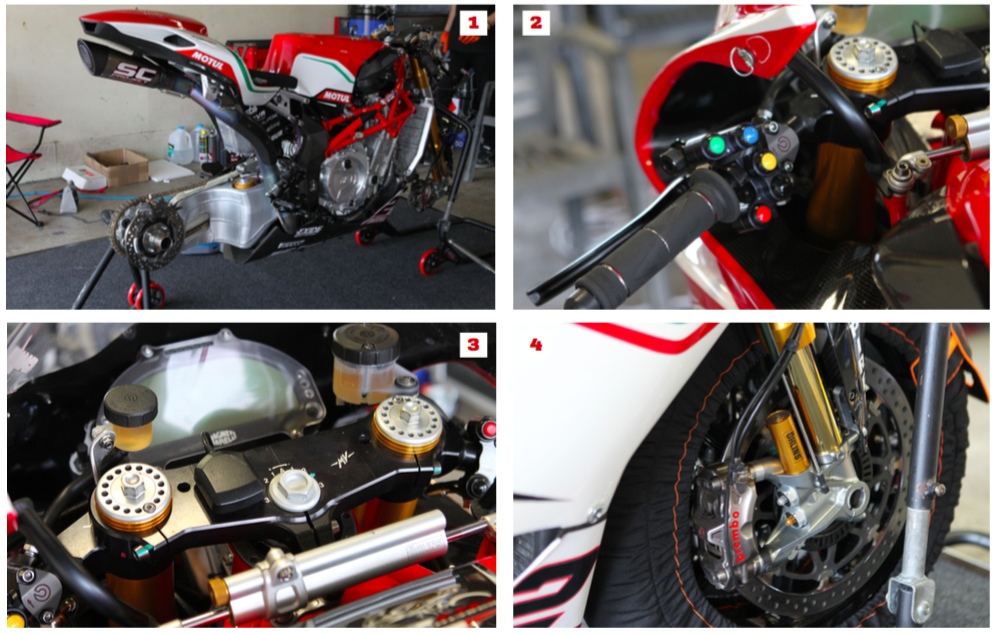
1. Racebike swinger is one of the big differences from the roadbike 2. Looking more Super Nintendo than Superbike, but the level of control over the electronics is leading edge 3. Helps having the race crew around when it comes to adjusting suspension settings 4. Dual 320mm discs at the front with Brembo four- spot radial calipers
Throwing my leg over Camier’s F4 RC for the first time was interesting. It’s a very spacious bike and that’s understandable as it has been developed around Leon, and he’s not short. It’s also quite high off the ground compared to the road version. The reason for raising the ride height is to help with changes of direction, and this bike certainly flicks from side to side easily.
The view from the cockpit is stunning – first class controls adorn it and provide that special touch that production bikes just don’t have. The Marelli dash was spitting out so much information my brain went in to overload. All the vital statistics are displayed in real time with a bunch of warning lights ready to start flashing if things go south, and the normal stuff like tacho, lap timer and shift lights are easy to see.
Once underway though it’s all business. The throttle action is smooth and so accurate. There is loads of leeway, letting you almost feel the grip of the tyre too easily. And that’s what a superbike is all about: tyre feel. The first time I rode the bike, at SMSP, I had a new rear fitted so didn’t really appreciate how well this bike finds grip – there was more drive exiting SMSP’s tighter bends than I think I’ve ever felt. But at the Island with its fast sweeping high-speed nature and a worn-out rear slick that adhesion was still there.
The Öhlins suspension is sublime and although over the past few years the WSBK regulations have tightened up, banning unobtainable factory GP-spec equipment, this current obtainable equipment works every bit as well at soaking and supporting as the factory items fitted a few years ago.
The feel of the Brembo brakes is mind boggling, especially how little pressure you need to make them work. Heading into Honda corner at PI with the anchors locked up it’s so controllable. As you squeeze the lever harder, the bike keeps its composure and lets you turn in even tighter with a load of brake pressure and feel.
Where the team have really worked wonders though is the chassis and its set-up. There are loads of little detail changes compared to the road counterpart which fundamentally alter the dynamics of this F4. I mentioned that it sits high, and normally that would make a bike feel like a seesaw to ride with lots of weight transfer – not ideal for fast times. But adjustments to the weight distribution, settings and swingarm have turned this superbike into one of the nicest, flattest-handling machines I’ve ever ridden. It doesn’t lift the rear on braking and it doesn’t claw skywards every time you give it a fistful.
Riding a superbike may sound simple: hop on and go faster! I wish it were like that. Holding line, changing line on the angle and driving out of turns is much easier than on a standard roadbike, but it takes time to get your head around what’s possible and what’s not. I’ve ridden lots of full-blown WSBK-spec bikes in my time but this is Sam’s first. He has a lot to take in and will learn that these bikes need to be taken by the ’bars and manhandled to get the most out of them – they really start to work when the rider is outside their comfort zone. For a guy with a nine-to-five job that’s the hard part, and although this bike has done mid-1.30s at the Island, a normal rider would probably lap at a similar pace to what they do on their road-based track bike to start with.
It freaks me out every time I ride one of these beasts as it takes me back to a time when I myself was once a WSBK guy and my first flying lap would be a 1m34s at the island. Those days are long gone and now I sit on the other side of the fence, which gives me the rare opportunity to see both perspectives and really appreciate the capabilities of Sam’s F4 RC. Not only is it good for Leon, it’s also good for non-aliens too.
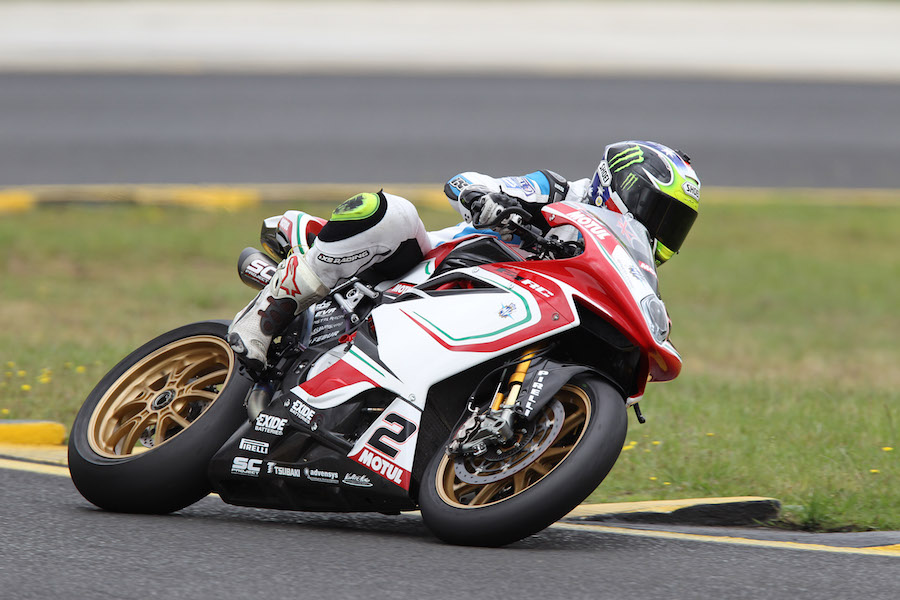
The owner says…
Sam, you have taken passion to the next level buying this bike. What was the thought process?
I am crazy for MV like a mother is for her kids. It is something that has developed over time and with my good fortune has allowed me to be one of the very few to own some very exclusive motorcycles in the MV stable. I am very well known within the MV community and a lot of my friends would call me crazy.
How did this whole thing come about? You don’t just trawl eBay or Gumtree for a cheap used WSBK bike…
Last year at Phillip Island WSBK I was taken into the garage of the MV team and was introduced to the team managers, Andrea Quadranti and Claudio Quintarelli. Upon walking into the garage, I saw Leon’s bike and instantly told myself I wanted it as part of my collection and as a new track bike, as I was looking to update my current track bike anyway.
Initially I thought there was no way it could happen and nobody would even bother to entertain my idea, but to my surprise Andrea said let’s talk about the possible purchase of the bike after the qualifying.
It takes a fair bit of effort to keep a proper Superbike up and running. Have you factored that in?
I have a spares list that could run or even build a second bike, or run the team for a year [laughs]. From two spare motors, three fairing sets, three wheel sets, three Suter clutches, two exhausts, rearsets, springs, radiators, forks etc. The list is long but I felt if I ever needed anything or crashed it I could fix it in 10 minutes and not need to wait like a real team would. I even ordered the full garage boards they set up in the pits so it will look like a team garage.
You’re letting us ride the bike at SMSP and Phillip Island. It’s your new baby – aren’t you nervous, letting me fang it around the track?
Though I love my motorcycles I am one who shares my bikes with my friends so they too can experience what it is to ride these beasts. What good would it be not to share these bikes with people who share your same passion?
The crew chief says…
We caught up with Paolo Piazza, the man responsible for keeping the wheels turning and Camier towards the front of the pack in 2016. Coming from a grand prix background, Paolo has adapted perfectly to the F4 and its nuances, giving the MV its best year yet.
What’s your background in racing?
I worked with the two-strokes from 1986, mainly the 125 and 250 machines, as a hobby. In 1997 it became my professional job, which I continued until I got the job with Forward Racing in 2013. It was a fantastic period where I learnt a lot about what it takes to make bikes go fast.
Working in MotoGP must have been a dream, so why did you come to MV?
I like a challenge and when I heard Forward and Reparto Corse MV were to have a collaboration for the 2016 season I was one of the technicians to put my hand up. To be able to make the switch to the Superbike project is an exciting one with great emotional reward. It is a big new challenge turning a roadbike into one which can win Superbike races.
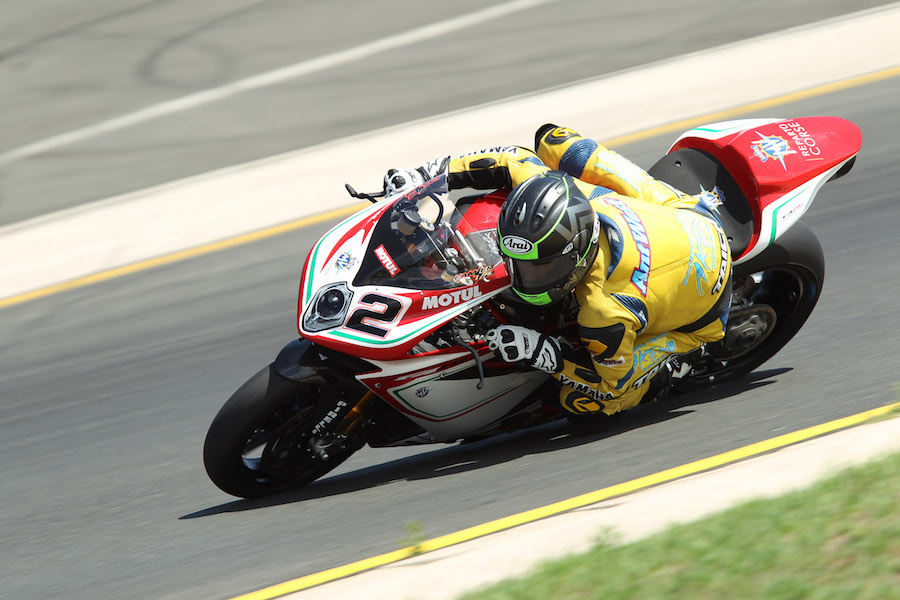
Ant West was also on hand to turn a few laps
How is it working with Leon Camier? He seems like a character.
2016 was my first year in World Superbikes and up until then I had only seen it on TV. I’ve been lucky to have Leon Camier as my rider. He gives optimum feedback and is fantastic at developing the bike. He is always at the top of his game and athletically strong but above all else he fights to the end in the race and that’s all I can ask for.
Can you improve the 2017 F4 Superbike?
We understand we need more power and that is something on the agenda. The bike also needs to go on a diet as it is still over the minimum weight allowance in the class. We want to work on the electronic package to make that extra power more usable too. We made a big step from 2015 to 2016 and we need to do the same again this year.
Any advice for Sam?
Sam has bought the unobtainable: a real factory Superbike. He will need to work hard to get the most out of the electronics systems on this bike, which is nothing like what you can buy on the open market. He has some good support from Parramatta MV and together with us he can enjoy his new bike. We factory guys love coming to Australia and any chance we get we will jump on the plane, so if Sam calls we are there.
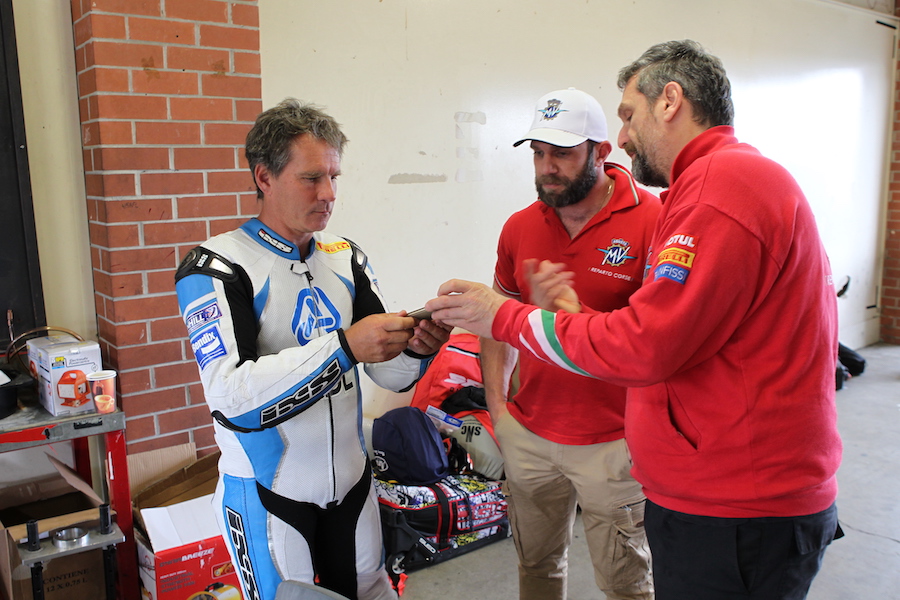
The rider says…
For the past couple of years Leon Camier has been giving the Reparto Corse Team feedback, and this shaped Sam’s 2016 machine. If there was ever a man to listen to about how to ride the bike, it’s him.
“The F4 is a great all-round package. It doesn’t do one thing brilliantly, but it does everything well, and that’s allowed me and the team to step it up a level compared to when I first started. We don’t have the massive budgets that some of the other manufacturers have but we nut things out, and with what we’ve got we do a great job. If I could say one thing to Sam about riding his new MV it would be not to rush it. This bike works well if you’re smooth on the power and don’t attack. The steel trellis frame absorbs bumps well so let it do its work and enjoy.”
